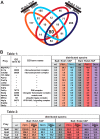Proteomic and Genomic Analyses of the Rvb1 and Rvb2 Interaction Network upon Deletion of R2TP Complex Components
- PMID: 26831523
- PMCID: PMC4813713
- DOI: 10.1074/mcp.M115.053165
Proteomic and Genomic Analyses of the Rvb1 and Rvb2 Interaction Network upon Deletion of R2TP Complex Components
Abstract
The highly conserved yeast R2TP complex, consisting of Rvb1, Rvb2, Pih1, and Tah1, participates in diverse cellular processes ranging from assembly of protein complexes to apoptosis. Rvb1 and Rvb2 are closely related proteins belonging to the AAA+ superfamily and are essential for cell survival. Although Rvbs have been shown to be associated with various protein complexes including the Ino80 and Swr1chromatin remodeling complexes, we performed a systematic quantitative proteomic analysis of their associated proteins and identified two additional complexes that associate with Rvb1 and Rvb2: the chaperonin-containing T-complex and the 19S regulatory particle of the proteasome complex. We also analyzed Rvb1 and Rvb2 purified from yeast strains devoid of PIH1 and TAH1. These analyses revealed that both Rvb1 and Rvb2 still associated with Hsp90 and were highly enriched with RNA polymerase II complex components. Our analyses also revealed that both Rvb1 and Rvb2 were recruited to the Ino80 and Swr1 chromatin remodeling complexes even in the absence of Pih1 and Tah1 proteins. Using further biochemical analysis, we showed that Rvb1 and Rvb2 directly interacted with Hsp90 as well as with the RNA polymerase II complex. RNA-Seq analysis of the deletion strains compared with the wild-type strains revealed an up-regulation of ribosome biogenesis and ribonucleoprotein complex biogenesis genes, down-regulation of response to abiotic stimulus genes, and down-regulation of response to temperature stimulus genes. A Gene Ontology analysis of the 80 proteins whose protein associations were altered in the PIH1 or TAH1 deletion strains found ribonucleoprotein complex proteins to be the most enriched category. This suggests an important function of the R2TP complex in ribonucleoprotein complex biogenesis at both the proteomic and genomic levels. Finally, these results demonstrate that deletion network analyses can provide novel insights into cellular systems.
© 2016 by The American Society for Biochemistry and Molecular Biology, Inc.
Figures







References
-
- Zhao R., Davey M., Hsu Y. C., Kaplanek P., Tong A., Parsons A. B., Krogan N., Cagney G., Mai D., Greenblatt J., Boone C., Emili A., and Houry W. A. (2005) Navigating the chaperone network: an integrative map of physical and genetic interactions mediated by the hsp90 chaperone. Cell 120, 715–727 - PubMed
-
- Te J., Jia L., Rogers J., Miller A., and Hartson S. D. (2007) Novel subunits of the mammalian Hsp90 signal transduction chaperone. J. Proteome Res. 6, 1963–1973 - PubMed
-
- Boulon S., Marmier-Gourrier N., Pradet-Balade B., Wurth L., Verheggen C., Jady B. E., Rothe B., Pescia C., Robert M. C., Kiss T., Bardoni B., Krol A., Branlant C., Allmang C., Bertrand E., and Charpentier B. (2008) The Hsp90 chaperone controls the biogenesis of L7Ae RNPs through conserved machinery. J. Cell Biol. 180, 579–595 - PMC - PubMed
-
- Zhao R., Kakihara Y., Gribun A., Huen J., Yang G., Khanna M., Costanzo M., Brost R. L., Boone C., Hughes T. R., Yip C. M., and Houry W. A. (2008) Molecular chaperone Hsp90 stabilizes Pih1/Nop17 to maintain R2TP complex activity that regulates snoRNA accumulation. J. Cell Biol. 180, 563–578 - PMC - PubMed
-
- Boulon S., Pradet-Balade B., Verheggen C., Molle D., Boireau S., Georgieva M., Azzag K., Robert M. C., Ahmad Y., Neel H., Lamond A. I., and Bertrand E. (2010) HSP90 and its R2TP/Prefoldin-like cochaperone are involved in the cytoplasmic assembly of RNA polymerase II. Mol. Cell 39, 912–924 - PMC - PubMed
Publication types
MeSH terms
Substances
LinkOut - more resources
Full Text Sources
Other Literature Sources
Molecular Biology Databases

